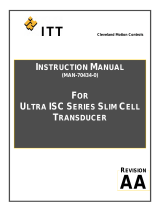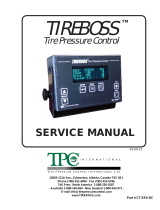Page is loading ...

Rev B Date :5.4.21.JG
SI Onboard
Trojan Installation Instructions
SI OnBoard - USA
5920 South 194th Street | Kent, WA 98032 | USA
Sales Support: 800-638-5111
Technical Support: 626-202-5047
E-mail: si[email protected]
SI OnBoard - Canada
#106-1765 Springfield Road
Kelowna, BC V1Y 5V5
Ph: +1-800-989-1499
|
+1-250-860-8450
Fax: +1-250-762-9811
E-mail: si[email protected]

1
Contents
1. Introduction ........................................................................................................................................ 2
2. Front Axle Installation ......................................................................................................................... 3
4. Tightening Transducer Bolts ............................................................................................................... 6
5. Installing Plastic Transducer Cover...................................................................................................... 6
6. Installation Checklist ........................................................................................................................... 7
7. Assembling the J-Bracket and Setup Bracket ...................................................................................... 8
8. Surface Preparation ............................................................................................................................ 9
9. Weld the J-Bracket Assembly ............................................................................................................ 11
10. Install the Deflection Sensor ......................................................................................................... 11
11. Tightening J-Bracket Transducer Bolts .......................................................................................... 12

2
1. Introduction
1.1. Truck operators who need consistent and accurate monitoring of their load weights for safe and legal
operation can depend on equipment from SI Onboard. The Trojan Transducer developed by our team of
engineers will provide years of dependable service, but it must be properly installed in appropriate
locations. While the installation is relatively simple, all instructions must be faithfully followed to insure
not only system accuracy, but also durability for all components.
1.2. The basic component of this system is a deflection sensor- also known as a Trojan Transducer. The Trojan
is bolted to mounting blocks which are welded in place on a truck’s front steer axle and a specially
designed J-Bracket that is welded to the rear drive axle housing. As a load is added or removed, the truck’s
suspension is strained and bends ever so slightly. This bending is also felt by the Trojan Transducer and an
electrical signal is then sent from the Trojan Transducer to a meter in the truck’s cab. The strength of this
signal is determined by the amount of strain sensed by the Trojan Transducer.
1.3. Because the transducers are mounted to the side of the ”L” shaped mounting blocks, they are referred to
as “Side Mount.” This term does not refer to the mounting position of the blocks themselves. In fact, all
mounting blocks for this system are installed in top of walking beams, thru-Trunnion, axles and front axles.
The locations of the mounting block / transducer combination is very important. Adequate clearance
above the transducer installation is also crucial. Detailed instructions about location are provided in this
installation manual.

3
2. Front Axle Installation
2.1. Measure and mark the center of the axle, both side to side and front to back. [see Figure 1].
Figure 1
2.2. Check for adequate clearance between transducer assembly and oil pan. To do so, measure the
suspension travel distance between top of spring and stop. Since the transducer assembly, including
cover, requires 3”, the measurement from the oil pan to the axle must be at least the distance of
suspension travel plus 3”. If there is not enough space, call the factory for additional information.
2.3. Clean a 12” space in the center of the axle. Remove all paint, dirt and grease, exposing bare metal. Use
solvent and a wire brush as necessary.
2.4. Using two cap screws from the installation kit, bolt spacer bar to mounting blocks, with width determined
by the load limit of the axle. Note that the mounting block holes are elongated. This allows adjustment of
the space between the inside edges of the mounting blocks from 2 ½“ to 3 ½”. The load rating of the axle
determines the spacing of the blocks, See Table 1.

4
Load Rating
Space Between Mounting Block
12,000 lbs.
2 ½”
14,000 lbs.
2 ½”
18,000 lbs.
2 ½”
20,000 lbs.
3”
Table 1
2.5. Position the mounting blocks/spacer bar on the axle and clamp in place. The blocks should sit flat without
rocking or without gaps under them. Light grinding may be required. The groove on the bottoms of the
blocks should be directly over the web of the axle.
2.6. Weld the mounting block/spacer bar unit to the axle along two edges of each mounting block, see Figure
2. Do not weld all around the mounting block and do not weld on the sides with the “V” groove, see
Figure 2. Use low hydrogen rod such as AWS E 7016.
Figure 2
2.7. Unbolt and remove spacer bar.
2.8. Clean blocks and transducer mounting surfaces with alcohol or other solvent.
2.9. Bolt the transducer to the mounting blocks with the bolt heads and washers on the transducer side and
the nuts and washers on the mounting block side. Use the two 3/8”-24 cap screws and four washers. Be

5
sure that the top of the transducer is up. If the transducer has a rib running along its length, the rib side
goes up. If the transducer has a threaded pigtail connector, the connector should come out of the bottom
at the end of the transducer. Also position the transducer so that the pigtail can be connected to the cable
coming from the meter in the cab. This is usually the drivers side. Hand tighten only.

6
4. Tightening Transducer Bolts
4.1. Make sure the transducer mounting bolts are hand tightened only.
4.2. Connect cabling to meter and transducers. The meter and cables may be placed on the shop floor
temporarily and hooked to the transducers.
4.3. Connect power to the meter and make sure the meter is programmed and the system is working property.
(See owner’s manual).
4.4. “Zero out" the meter. With the 9100 series meters, set tare 1 and tare 2 to zero and cal 1 and cal 2 to
100,000.
4.5. While watching the meter, torque the mounting bolts to 25 ft. lbs. This will cause the meter to show a
load. The readings should be 0 to 2500 lbs. If the meter exceeds this amount, loosen the bolts and
carefully retighten them in sequence until the 0 to 2500 lb range is met. The amount of change varies
depending on whether you tighten by turning the head of the bolt or by turning the nut.
5. Installing Plastic Transducer Cover
5.1. Clean welding residue with a clean wire brush.
5.2. Mask off the area around the transducer installation.
5.3. Paint the transducer, mounting blocks and the area under the transducer. Use a high quality rust
preventative paint such as Rustoleum or Tremclad.
5.4. If the transducers are being installed on Hendrickson walking beams, attach the two warning labels
supplied. The smaller warning label should be placed on top of the walking beam between the mounting
blocks. The larger label should be attached in the web of the walking beam directly below the transducer
installation.
5.5. Clean the bottom flange of the cover.
5.6. Apply a bead of silicon sealant to the bottom of the flange.
5.7. Install the cover over the transducer.
5.8. Seal the holes at the end of the cover and around the cable from the transducer.

7
6. Installation Checklist
6.1. Make sure that adequate clearance is available above all transducers before installation. This will prevent
damage to the transducer from the oil pan, suspension or drive shaft.
6.2. Use only aluminum or steel mounting blocks with aluminum or steel suspension parts.
6.3. Make sure that all electrical connectors are tight.
6.4. Provide proper slack in pigtails or cables. This will prevent cable damage from suspension travel.
6.5. Use care when tightening bolts. Watch that meter doesn't exceed +/- 5000 lbs. Improper-tightening of
the bolts preloads the transducer and shortens its life.
6.6. Keep everything clean, both before and after transducer installation.
6.7. Paint transducer, mounting blocks and surrounding area with high quality rust preventative paint.
6.8. Attach warning labels to Hendrickson walking beam installations.
6.9. Note that the transducer must be removed from the front axle when the axle is straightened or aligned.
6.10. Completely seal the transducer cover around the bottom flange and holes in the ends.

8
7. Assembling the J-Bracket and Setup Bracket
Figure 3: Assemble the Setup Bracket
7.1. Ensure the alignment pin of the Setup Bracket (P/N 1400114) is flush and is touching the Right Side J-
Bracket (P/N 1400103R).
7.2. Securely tighten the supplied 3/8-24 x ¾ Grade 5 bolt (P/N 2801091).
7.3. Using the Left Side J-Bracket (P/N 1400103L), repeat Steps 1 and 2. Make sure all edges are parallel and
at the same height. See Figure 2.

9
Figure 4: Completing the Setup Bracket Assembly
8. Surface Preparation
8.1. Hold the J-Bracket Setup Assembly firmly on the top of the axle housing and mark the area inside the
two (2) large weld holes on the bottom of each J-Bracket.
8.2. Remove the J-Bracket Setup Assembly and set it aside.
8.3. Using a sander or grinder, fitted with 40 grit sandpaper, clean the area that were previously marked.
Clean down to bare metal.

10
Figure 5: Clamping the J-Bracket Assembly to the Axle Housing

11
9. Weld the J-Bracket Assembly
Figure 6: Install the Deflection Sensor
10.Install the Deflection Sensor
10.1. The Deflection Sensor (P/N 8300370-10) is now ready to be installed into the welded J-Brackets.
10.2. Thoroughly clean the mounting surfaces with Brakleen. Ensure there is no paint on any mating
surfaces.
10.3. Attach the Trojan Deflection Sensor (P/N 8300370-10) with the cable exiting towards the center
of the Axle Housing.
10.4. Ensure the word “TOP” is facing up.
10.5. Install the Trojan Deflection Sensor (P/N 8300370-10) using the supplied two (2) Grade 8 Mount
Bolts (P/N 2800363), four (4) Grade 8 Washers (P/N 2800905) and two (2) Grade 8 Hex Head
Nuts (P/N 2800220).
10.6. Hand Tighten the Hex Head Grade 8 Nuts (P/N 2800220).

12
11.Tightening J-Bracket Transducer Bolts
11.1. Make sure the transducer mounting bolts are hand tightened only.
11.2. Connect cabling to meter and transducers. The meter and cables may be placed on the shop floor
temporarily and hooked to the transducers.
11.3. Connect power to the meter and make sure the meter is programmed and the system is working
property. (See owner’s manual).
11.4. “Zero out" the meter. With the 9100 series meters, set tare 1 and tare 2 to zero and cal 1 and cal
2 to 100,000.
11.5. While watching the meter, torque the mounting bolts to 25 ft. lbs. This will cause the meter to
show a load. The readings should be 0 to 2500 lbs. If the meter exceeds this amount, loosen the bolts
and carefully retighten them in sequence until the 0 to 2500 lb range is met. The amount of change varies
depending on whether you tighten by turning the head of the bolt or by turning the nut.
/





